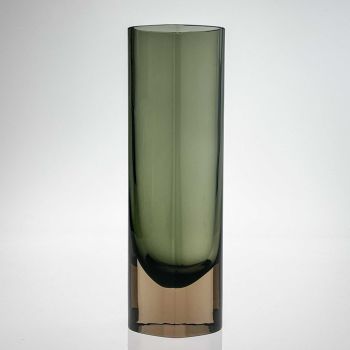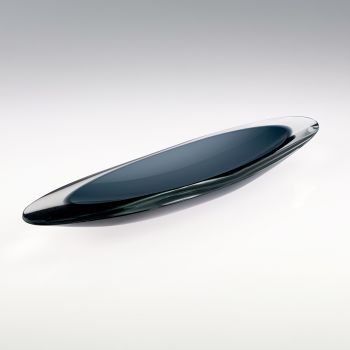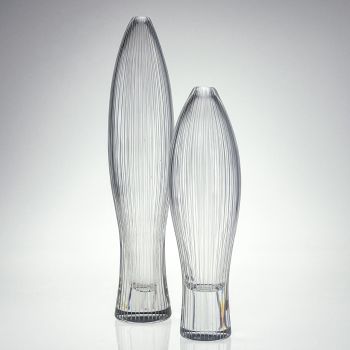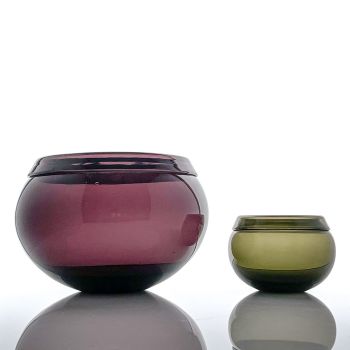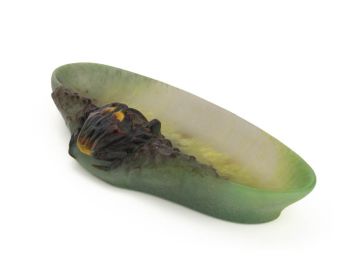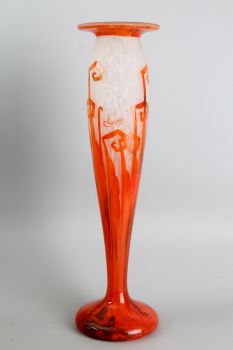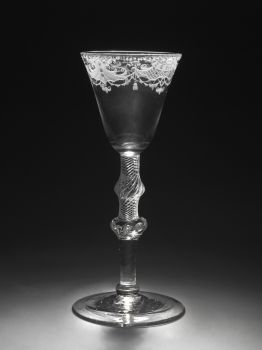A largest size glass art-object "Pajunlehti" or "Willowleaf" in unusual colour light-brown, model KF 1960 - 1965
Kaj Franck
Glas
4 ⨯ 24 ⨯ 9 cm
ConditionVery good
€ 750
Van Kerkhoff Art
- Over kunstwerkA free blown, flared, cut and polished light brown and clear cased glass art-object "Pajunlehti" or "Willowleaf", model KF 210. Designed by Kaj Franck in 1954 and executed by the Nuutajärvi-Notsjö glassworks circa 1960.
These art-objects were made in three different size-ranges and several colours between 1954 and 1963. This being a largest size example in a unusual light brown colour. The same colour used in the Nuutajärvi-Notsjö glassworks for one of the "Prisma" variants.
This Wilowleaf is etched-signed underneath the base. The etching has faded though and only K. F. remains readable. Either it was signed this way or the rest of the designers name has faded. The piece is in good condition, scratches underneath the base but no cracks or chips.
About Kaj Franck
Kaj Franck (Vyborg, Finland 1911 – Santorini, Greece 1989) was an influential Finnish designer and leading figure in Finnish art-world between 1940-1980.
Born in 1911 on the Finnish Russian border in a family of architects (his grandfather was director of the famous Arabia Ceramics factory) of Finnish-German-Swedish decent.
He attended the furniture department of Taideteollinen korkeakoulu (todays Aalto university school of Arts, Design and Architecture) in Helsinki.
After his studies he worked as a freelance designer until he joined Arabia as a designer in 1945. In 1950 he became Arabia’s Artistic Director. He also designed glass-objects for Iittala between 1946 and 1950 and between 1950 and 1976 for Nuutajärvi-Notsjö glassworks.
From 1945 onwards he worked as and educator at Taideteollinen korkeakoulu and he became the institute's Artistic Director in 1960.
His modernist designs in everyday tableware glass are considered to be a revolution and classic Finnish design object (most notably his Kilta tableware and Kartio glassware).
He is often referred to as “the conscience of Finnish design”, moderation, ecology and equality were Franck’s principles. He strove to minimise the number of everyday objects we need in our lives, drawing attention to the sustainability and life cycle of products.
Kay Franck’s designs are in collections of numerous museums all over the world. Among others: Design Museum Helsinki, Museum of Modern Art, New York, Stedelijk Museum Amsterdam and The British Museum, London. He was a recipient of many prizes. Most notably the Lunning prize in 1955, a “Grand prix” and several “Gold medals” at the Triennale di Milano.
Today his name is used for the prestigious “The Kaj Franck Design Prize” annually awarded by the Finnish Design Forum.
Execution
Nuutajärvi-Notsjö glassworks, Finland circa 1960
Marked
Etched-signed underneath the base. The etching has faded though and only K. F. remains readable. Either it was signed this way or the rest of the designers name has faded.
Condition
This art-object is in good vintage condition, some minor scratches and wear consistent with age and use. No chips or cracks.
Literature
Marianne Aav (ed.), Kaj Franck, Universal Forms, p.322
Dimensions
H. 4.9 cm
W. 24.9 cm
D. 9.8 cm
Weight 843 grams - Over kunstenaar
De Finse keramiek- en glasontwerper Kaj Franck (1911-1989) besefte een krachtige waarheid in zijn indrukwekkende carrière: eenvoudig is mooi. Ondanks dat de wereld zich in een steeds sneller tempo beweegt, van het ene decennium naar het andere, blijft die simpele waarheid bestaan. Franck's inspiratie en principes begonnen een traditie in Fins design, die nog steeds springlevend en sterk is. Zijn bekendste werken zijn de Iittala Teema- en Kartio-series, en zijn erfgoed maakt deel uit van elk Fins huis.
"Ik wil gebruik maken van objecten die zo voor de hand liggend zijn dat ze niet opvallen", definieerde Kaj Franck zijn eigen werk. Zijn ontwerpen kwamen tegemoet aan de basisbehoeften van de mens en dienden hen tegelijkertijd gereedschappen met eigenschappen van alledaagse voorwerpen. Franck was ook geïnteresseerd in lage- kostte massaproductie en schuwde materialisme, wegwerpcultuur en pronken. Francks wereld bestond uit wiskundige basisvormen en eenvoudige vormen, alleen versierd met sterke kleuren.
Uitgangspunt van het werk van Franck was bruikbaarheid gecombineerd met schoonheid. Hoewel het vandaag de dag vanzelfsprekend lijkt, waren zijn gedachten in zijn eigen tijd radicaal. Franck scheidde stijlen en modetrends van traditie en gaf er een geheel nieuwe betekenis aan. In de periode 1952-53 toonde Franck aan dat serviesgoed niet al te ingewikkeld hoeft te zijn met de release van de Kilta-serie als sterk statement - het was een nieuw idee dat iedereen de tafel kon dekken volgens zijn eigen behoeften .
Franck begon zijn ontwerpen door zich te concentreren op het idee of het onderliggende concept, niet op de vorm. Deze nadruk op het idee-aspect van design werd ook doorgevoerd in zijn werk als docent en later als artistiek directeur aan de Universiteit voor Kunst en Design in Helsinki. Franck was ook een van de eerste pleitbezorgers van recycling, en hij wordt vaak het "geweten van Fins design" genoemd. Franck won vele prijzen in zijn indrukwekkende carrière en werd internationaal beroemd. Tegenwoordig is de Kaj Franck Award de meest prestigieuze designonderscheiding van Finland .
Bent u geïnteresseerd om dit kunstwerk te kopen?
Artwork details
Related artworks
- 1 - 4 / 9
Børge Mogensen
Teak wood “dropleaf” desk – Søborg Møbler, Denmark circa 19551950 - 1960
Precio a consultarVan Kerkhoff Art
1 - 4 / 24Amalric Walter
Amalric Walter & Henri Bergé – Crabe plumier1920 - 1929
Precio a consultarAntiques Emporium
Artista Desconocido
François-Théodore Legras – Tall “Fleurs de Pommier” apple blossoms vase1900 - 1909
Precio a consultarAntiques Emporium
Gabriel Argy-Rousseau
Gabriël Argy-Rousseau – Crabes et Algues vase – 19201920 - 1929
Precio a consultarAntiques Emporium
1 - 4 / 24René Lalique
Un jarrón temprano 'Bluets' diseñado por Rene Lalique (1860-1945)1910 - 1920
Precio a consultarLennart Booij Fine Art and Rare Items
Gabriel Argy-Rousseau
Gabriël Argy-Rousseau – Crabes et Algues vase – 19201920 - 1929
Precio a consultarAntiques Emporium
1 - 4 / 24Børge Mogensen
Teak wood “dropleaf” desk – Søborg Møbler, Denmark circa 19551950 - 1960
Precio a consultarVan Kerkhoff Art
1 - 4 / 12













